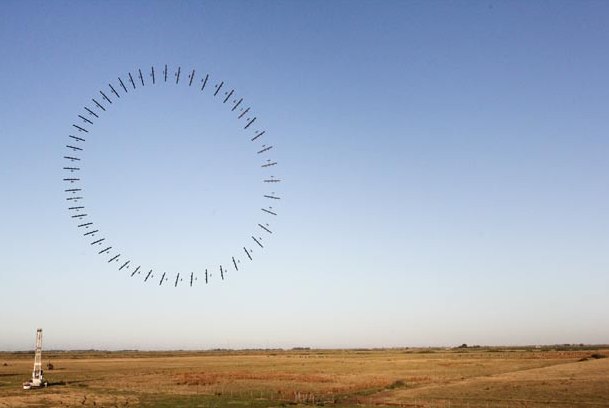
For over a century, researchers and specialists have cooked up approaches to draw power from ‘high height’ winds. Up to this point, however, the engineers’ compass has surpassed their grip. Welcome Makani Power (‘makani’ is the Hawaiian word for wind), one of a few organizations out to change that. The Makani Kite is about a one hundred foot long, carbon fiber wing lined with turbines and is fit for flying at an altitude of eight hundred to two thousand feet in the sky, creating six hundred kilowatts of energy along the way. Energy is exchanged to the electrical network by means of long wires gripping the ground or to floating out at the sea. The gadget files in circles opposite the wind, copying the way a turning turbine cutting edge works; the flaps make this effect possible.
Makani’s layout permits the flying wind turbine to draw energy at an unsubsidized expense against that of coal and cheaper than your average wind turbine cost.
Image Source: Google Image – A visualization of how a Makani Power Kite works via tether. The tether looks like the string of the kite, but is made of conductive wires surrounding a high strength core. The tether carries energy from the kite to the grid, and connects the kite to the ground station.
However, the airborne wind turbines have received some negative criticism, an excessive amount of it. That is because the majority of the problems with the current design stem from the arrangement of the turbines. As a portable, higher elevation vehicle, the airborne wind turbine will likely face a ton of issues. Some positive notes however, are that in the event that a herd of fledglings moves into a region, the turbine itself can essentially be moved. Additionally, birds won’t have the capacity to roost on an airborne turbine and definitely not settle on one.
In its beginning stages, the Makani airborne wind turbine pulled in a considerable measure of consideration for its blend of periphery and attainability. In 2006, Google invested $10 million in the organization through a renewable energy initiative. In 2010, Makani was granted an award from the Advanced Research Projects Agency for the Department of Energy (ARPA-E) in light of a call for a proposition for disruptive technologies and ‘long shot’ projects; those utilizing a profoundly diverse quality of frameworks to overturn existing ideal models. The enthusiasm for clean energy from ARPA-E was a piece of a larger exertion that columnist Michael Grunewald, as of late, called ‘the quiet green transformation.’ An investment of more than ninety billion dollars in wind, sun powered, and bio fuels ventures, not to mention a variety of other things.
Image Source: Google Image – The ground station holds onto the tether, and is used as a resting place for the energy kite when not in flight. The ground station occupies less ground space and is significantly smaller than conventional wind turbines.
Now, after two years and millions of dollars later, the team has a working model which they have since scaled up; they are, as of now, testing a wing that is thirty feet long and produces thirty kilowatts of energy. Hardham estimates that Makani is three to four years from having the full scale airborne turbine industrially accessible. He imagines squadrons of these turbines buzzing around in incredible circles for quite a long time. At least now, building these things is no longer a test in principle, it is only a matter of design.
SOURCE: Google Makani







wtf who said this was free? This isn’t free at all stop misinformation ffs